Contents
ABSTRACT
Bioaccumulation and biotransformation of heavy metals cause serious pollution in aquatic ecosystems. This has attracted widespread attention to its negative effect on ecological and human health. In recent years, several studies have been done in this area. Among all the heavy metals, Cadmium (Cd) and lead (Pb) have been widely reported for their toxic effect. However, detailed research activity on these two pollutants in aquatic ecosystems has not been mapped. It is important to capture the key topics and domains in which research is happening. The present study attempts to address this gap. A detailed Scientometrics study was undertaken to capture the heavy metal pollution in river systems. The 33,414 research papers were identified from a topic search covering the period 2010 to 2021 from the ‘web-of-science’ database. The social network analysis approach was used for understanding the structure and dynamics of the research. The study identifies the following as major nodes in the network constructed from author keywords assigned to the research papers namely heavy metal (primarily lead, cadmium), bioremediation, carbon nanotube, and sequential extraction. The thematic areas were identified as ecological risk, adsorption, atmospheric deposition, and potential ecological risk as major domains of research namely. The study has implications for research assessment and alerting the community and policymakers to the concerns about the adverse effect of these metals on aquatic ecosystems.
INTRODUCTION
Water is a key element for all the types of life existing on our earth. River water is the main source of irrigation for the agriculture system. Due to fast-track groundwater depletion and poor irrigation systems, agriculture accounts for 90% of water use. About 195 million hectares of land are used for cultivation. Of this, approximately 63% is rain-fed while the remaining agricultural land depends on irrigation. Additionally, several wildlife sanctuaries are located on the banks of rivers and their backwaters. Hence rivers are critical to their survival. Further, they also provide a livelihood to millions of people.[1]
Among the key influencers that stress water resources is the population size and growth as there is an increasing need for water for industrial and agricultural growth along with fulfilling the basic need of drinking water. This development deteriorates the quality and quantity of water resources. More than 30% of the world’s population does not have access to safe drinking water.[2,3] In a developing nation, the importance of surface water sources is very high, considering their requirement for various domestic, commercial, and irrigation activities. Consequently, examining the pollution status in surface water sources, especially rivers is very significant.[4] Various water quality indices had been developed by quantifying the levels of pollution and consistent monitoring of the various river water quality parameters. Among all the contamination indices, the Heavy Metal Pollution Index (HPI) was found to become the most efficient method for ranking the quality of water.[5] Past few decades, heavy metal pollution has been one of the major global issues due to its abundance, bioaccumulation, and non-degradable nature.[6] Heavy metal toxicity possesses harmful effects on ecological, evolutionary, nutritional, and environmental areas. The presence of heavy metals in river water above their permissible level may cause a significant threat to human health and environmental systems. Riverine systems can transport heavy metals to hundreds of kilometres along the hydrological gradient in a relatively short period. This may be responsible for creating toxic effects at points distant from the source of contamination.[7]
India epitomises to a large extent the challenges of water availability and quality. Thus, some insights from India are useful to put the key issues in context. As per BIS (Bureau of Indian Standards), each metal has its permissible limit in the environment. Metals are important nutritional constituents that play an important role in the functioning of living organisms. Beyond a limit, they cause health and environmental problems. Among the non-nutrient and highly toxic heavy metals, Cd (cadmium) and Pb (Lead) are the two most highly prevalent heavy metals in the Indian River system.[8]
Cadmium is an element that occurs naturally and uniformly distributed in the Earth’s crust. It is generally estimated to be present at an average concentration of 3 µg/L as per WHO (World Health Organization) and 5 µg/L as per USEPA (United States Environmental Protection Agency). The major sources of water contamination by cadmium are industrial discharge and leaching from landfill areas. Drinking water is generally contaminated with a galvanized iron pipe and plated plumbing fitting of the water distribution pipes. It ranks next to mercury in its toxicity. The gastrointestinal tract is the major route of Cd uptake in both humans and animals. However, only a small amount of cadmium intake is absorbed by the body and is stored mainly in bones, liver, and, in case of chronic exposure, kidneys. The widely reported Cd poisoning itai-itai boy occurred in Japan after World War II. There was severe pain in the body and joints and the people cried ITAI –ITAI (it hurts-it hurts). Lead (Pb) is the most common heavy metal. It is generally estimated to be present at an average concentration of 10 µg/L as per WHO and 15 µg/L as per USEPA. Among the several stable isotopes that exist in nature, 208Pb is the most abundant. It is used mainly in the production of lead-acid batteries, solder, and alloys. Though it is a non-nutritional element it is found in all human tissues and organs. It is known as one of the systemic poisons because, once absorbed into the circulation it will distribute throughout the body, where it affects various organs and tissues. It inhibits haematopoiesis because it interferes with heme synthesis, and may cause anaemia. According to the CDC (Centres for Disease Control and Prevention, US Federal Agency), lead poisoning is the most common and serious environmental disease affecting young children.
Thus, considering the role of river water in human sustenance, it is important to monitor and regulate the water quality efficiently. An increase in the number of toxic pollutants from multiple sources makes the characterization of pollutants practically in-executable.[9,10] An integrated multidisciplinary approach has been devised for accurate monitoring of pollution status across the globe. This study attempts to capture global influential research and insights on the scenario of the river water system concerning heavy metal pollution. It does an exhaustive analytical examination of research papers in this area to discover where and what type of research is happening in this domain globally.
LITERATURE REVIEW
In a couple of years, the acceleration in industrialization has led to an increase in heavy metal emissions. Activities like mining, smelting and metal treatment, traffic, and dumpsite areas cause heavy metal pollution which is a serious threat to human health.[11] Continuously, one by one various incidents occur in succession that increase the risk of heavy metals to human health, and still, their results are seen in young generations. For example, Minamata disease in Japan is caused due to mercury pollution, and itai-itai disease is caused by cadmium pollution.[12] In Bangladesh, arsenic and lead contamination cause various health problems in children.[13] This is also prevalent in the eastern part of India. Various studies show that most heavy metals and metalloids are carcinogens and affect the aetiology of several diseases, such as cardiovascular, kidney, nervous system, blood, and bone diseases.[14] The everlasting metal toxicity threat for the aquatic environment has been enhanced recently and Cadmium (Cd) and Lead (Pb) are considered major environmental problems due to their high carcinogenic and anticarcinogenic toxicities.[15] They have a long-term existence and are highly toxic to humans, plants, and animals.[16] Once absorbed, they cause infections in the liver and kidneys, and now emerging evidence suggests their genetic toxicity.[17] In aquatic ecosystems, Cd and Pb exposure can increase the formation of Reactive Oxygen Species (ROS) in cells, which leads to oxidative damage to biological systems.[18]
Heavy metals are non-biodegradable, they only convert from active form to inactive form by a wide range of processes and pathways.[19] On the other hand, due to the high toxicity, bioaccumulation, and bio-enrichment, heavy metal pollution is still a major problem of global concern and has received increasing attention. Scientists conduct extensive research on heavy metal emissions, pollution, health risk assessments, and pollution control and management which provide valuable information.[20] Maurya et al., 2019 studied the Bioaccumulation and potential sources of heavy metal contamination in fish species in the river Ganga basin and its possible human health risks.[21] They observed the presence of five heavy metals Zn, Pb, Cu, Cd, and Cr in most consumable fish species i.e., Cirrhinus mrigala, Cirrhinus reba, Catla catla, Lebio rohita, Crossocheilus latius, Clupisoma garua, and Mystus tengara, collected from local markets of Varanasi, Allahabad, Mirzapur, and Kanpur of Uttar Pradesh, India. Similarly, Rajesh Kumar and Li, 2018 studied the Bioaccumulation of heavy metals in fish species from Meiliang Bay, Taihu Lake, a large, shallow, and eutrophic lake in China.[22] They observed the accumulation of heavy metals (Cr, Cu, Cd, Pb) content in freshwater edible fishes Cyprinus carpio Linnaeus and Pelteobagrus fulvidraco. Therefore, it is essential to have a global overview of sources, human health risk factors, and control strategies for heavy metals. This will help to identify research trends, track research hotspots, and determine research direction in future years.
Bibliometric analysis is an effective and widely accepted method to identify research trends and hot issues based on research publications.[23] Scientists have already conducted various scientometric analysis reports on heavy metal pollution in the soil ecosystem as well as the groundwater system. Ouyang et al., 2018, comprise a report which explores various factors related to heavy metal loss from agricultural watersheds to the aquatic ecosystem.[20] Irfan et al., 2021 present the global trend of cadmium in freshwater with the help of bibliometric analysis.[24] Li et al., 2019 present various research hotspots and trends in the phytoremediation of heavy metal through various qualitative and quantitative bibliometric and scientometric analysis methods.[25] Wang et al., 2021, present the recent trends in source appointment of soil heavy metals by scientometric analysis.[26] They cover the research trend of 20 years from 2000 to 2020. No such study has been done that captures the overall research on heavy metal pollution in river systems and draws insights into the key domains where research is happening and draws detailed insights from that. This article attempts to address this gap by mapping the global research on heavy metal pollution in the river water system.
OBJECTIVE AND RESEARCH QUESTIONS
The key purpose of this study is to analyse the research output on heavy metal pollution using publications covering the period 2010 to 2021. This study intends to develop a comprehensive and systematic assessment of water pollution; understand the research trends and thereby recognize the areas of major research intensity and areas which need more research attention. More specifically, this study focuses on the growth pattern, both observed and expected by key institutions, countries, and most-productive researchers who are contributing significantly to the development of core domain knowledge and understanding the behaviour of the knowledge networks therein. India is taken as a specific case for investigation as it epitomises the challenges of river pollution to a large extent in developing countries.
This study attempts to capture insights into the following aspects:
The global structure and dynamics of research in heavy metal pollution in river water
The areas of research activity where India is prominently present
Based on the above, it draws implications for research and policy. The paper contributes to the current discussion on Sustainable Development Goal 06 on clean water and sanitation.
METHODOLOGY
Social Network Analysis (SNA) tools and techniques were used to analyse the data. SNA helps to understand the structure and dynamics of a research field, particularly useful in bringing out the relational and positional characteristics of a network. This provided a deeper insight to capture how the research is happening in this area. Papers covered by the Web of Science (WoS) database for the period 2010-2021 was the analytical set for this study.[27] The Study uses two centrality measures i.e., Degree centrality and Betweenness centrality. Degree Centrality helps to find the central node in the Network. While Betweenness centrality measures the number of times a node lies on the shortest path between other nodes. Keywords co-occurrence analysis to recognize and monitor the direction of research and development in the respective hotspot areas.[28] Keyword Cluster analysis is used to group similar keywords to create several clusters having the same characteristics. Journal co-citation analysis was used to identify operational indicators for the heavy metals. Author Co-citation Analysis (ACA) is used to map knowledge domains and depict scientific intellectual structures.
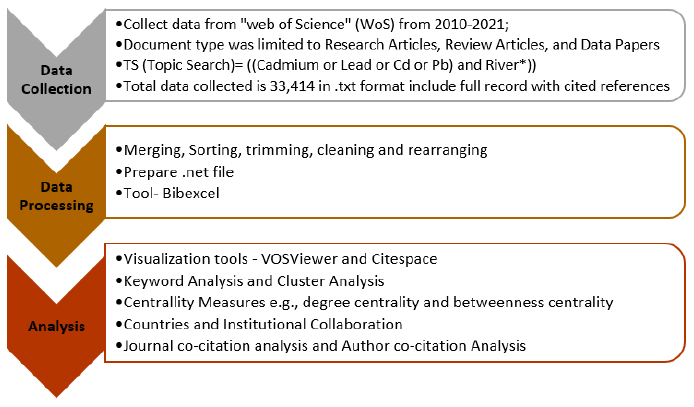
Figure 1:
Conceptual framework of Methodology
Data
The papers were extracted from the WoS Topic search field using the search string ((Cadmium or Lead or Cd or Pb) and River*). The topic search field implies all papers extracted that have this string in the title or abstract. The document type was limited to research and review articles and covered full records with cited references.
The study undertook a systematic process to clean the data and remove redundancy. A set of representative keywords for example was identified through an elaborate process. Those keywords were removed which had very less connection with our search topic. These are isolates identified through the SNA analysis. Keyword having the same meaning and differs only by singular and plural were combined. Keywords have the same meaning but are denoted by using different descriptions combined i.e., Lead and Pb, metal, and element.
The data was exported from Web of Science, as plain text that included all the Bibliometric information including title, abstract, authors, keywords, references, and citation data which are needed for analysis. The first important task was preparing the data for SNA-based analysis. The network files and map coordinates were prepared in Bibexcel. Analytics and visualisation were done using VOSviewer. CiteSpace was applied to undertake a more sophisticated analysis of citation, co-citation, and geographical distribution analysis and thus helps to draw an important conclusion.[20]
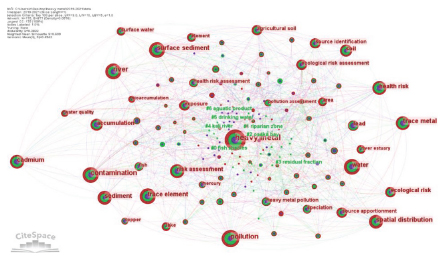
Figure 2:
Keyword analysis shows the research area network of heavy metal pollution
| Keywords (2010-2021) | Frequency | DegreeCentrality | Betweenness Centrality |
|---|---|---|---|
| Heavy metal | 292 | 46 | 0.47 |
| Contamination | 140 | 29 | 0.18 |
| River | 122 | 23 | 0.15 |
| Surface sediment | 96 | 17 | 0.11 |
| Spatial distribution | 78 | 15 | 0.09 |
| Accumulation | 59 | 13 | 0.07 |
| Trace metal | 78 | 12 | 0.06 |
| Water | 74 | 11 | 0.05 |
| Sediment | 74 | 9 | 0.04 |
| Cadmium | 68 | 9 | 0.04 |
| Health risk | 64 | 8 | 0.03 |
RESULTS AND DISCUSSION
Publications Trend
An increase in the number of publications from 2010-2021 signifies progress in the field of heavy metal pollution. We observed 5105, 6677, 9088, and 12544 publications in the year 2010-2012, 2013-2015, 2016-2018, and 2019-2021 respectively. Overall, 37.54% of a significant increase in the number of research publications was observed in 2019-2021 as compared to 2010-2012. This signifies that an increase in heavy metal pollution attracts our attention toward this area of research. However, metals with relatively high densities, atomic weights, or atomic numbers are known as heavy metals and thus toxic if consumed even in the concentration of ppb. For the past 11 years, this area is getting increasing attention globally.
Key Research Area
Keywords are the tool that helps the index and search engine to find articles of our interest. These words capture the essence of research articles and help to define the research issue, topic field, subfield, and methodology.[29] This study brings forth the research trend in the area of heavy metal pollution in river water systems and also the pollutants and diseases which have evolved. In the keyword co-occurrence visualization map, each node represents a keyword and the size of the node denotes the frequency of its occurrence i.e., the larger the size of the node, the higher the frequency of occurrence and vice versa (Figures 1 and 2). Three different colours represent the occurrence of that keyword in the three particular years from 2010-2021 and their width represents the frequency of occurrence.
Insights from the Figure 2 are further drawn from the centrality measure highlighted in Table 1.
Degree centrality is an important parameter as discussed in the methodology to identify the nodes which are playing a major role in the network. In Table 1 degree centrality of heavy metal is 46 denotes that it directly influences another area of research. Other new technologies and toxicology parameters are involved to explore this area of research. Accumulation of heavy metal in river water and surface sediment is on its edge. This is also the reason that these words are listed in the top ten keywords during the analysis. However, a decrease in the value of degree centrality i.e. health risk, cadmium, and sediment is much lower might be because these are the emerging topics in this area. Their occurrence is significantly high may be due to their involvement in other related areas like water quality, river, Agriculture soil, fish, ecological risk assessment, etc. this approach will give a holistic view of heavy metal contamination which help us to take appropriate action against this problem. (Table 1).
Cadmium and Lead used for search engines occur with frequencies 68 and 49 respectively. Figure 2 shows that Cd and Pb are the key heavy metals that were the most intense area of research globally. This highlights that these are the major areas of concern and thus are most actively researched. Among these, Cd and Pb are the highly researched heavy metals that may be due to higher toxicity and low ppb value. Keywords like health assessment, pollution index, human health risk assessment, contamination, and pollution connect to Cd and Pb. This shows the pervasive adverse impact of these two heavy metals. Due to urbanization and industrialization, the use of heavy metal increases day by day in various sectors like Agriculture, domestic, medicine, and various technological applications. This will lead to their day-by- day extensive distribution in the environment and increases the human health risk which may cause various incurable diseases. Cadmium and lead are among the priority metals that are of human health significance. According to the USEPA, these heavy metals are among the human carcinogens due to their systemic toxic action to induce multiple organ failure, even at lower concentrations.[30] Sequential extraction, source apportionment, and fractionation are the keywords that gave an idea about the methodology used for the extraction and identification of heavy metals in contaminated soil as well as in water samples. These extraction techniques help to classify Potentially Toxic Elements (PTEs) based on their association with phase or fraction in contaminated samples. This will help to improve the use of resources and reduce their adverse environmental effect.[31]
The presence of keywords like soil, sediment, drinking water, groundwater, estuary, fish, and tissue highlights these are a key problem domain which has attracted researchers’ attention. As we know, heavy metals are non-degradable thus they cannot undergo any microbial or chemical degradation process and persist in the soil for a longer period. Because of this, they enter the food chain either through contaminated soil or water bodies. They affect the natural physicochemical composition of soil as well as water.[32–35] Thus, it is not surprising that research activity is intense in these areas.
Speciation with frequency (30) signifies the bioavailability and mobility of heavy metals such as Cd, Pb, Cs, and Al in the soil column. This may increase the risk of potential uptake of heavy metals by plants, animals, and humans, which may cause genetic mutation in the species. Tack and Verloo defined the term speciation as “the identification and quantification of the different, defined species, forms or phases in which an element occurs”.[36]
Keyword Cluster Analysis
Keyword cluster analysis presents a better scenario of a heavy metal pollution network. It is a way to group related keywords into smaller clusters with similar meanings. Based on the Silhouette value, 12 keyword clusters were created out of these 7 were listed (Table 2). Silhouette value proposed by Kaufman and Rousseeuw in 1990, acts as an indicator that shows the homogeneity of the network.[26] Its value varies between 0 and 1, and above 0.5 signifies the reliability and rationality of the cluster.[37]
These clusters denote the different aspects of heavy metal pollution. Cluster 1 and Cluster 3 give us information on how an increase in heavy metal concentration increases the risk to human health and how we assess this risk. Due to the increase in industrialization, human exposure increases exponentially toward several industrial, agricultural, domestic, and technological applications.[38] Which increases the risk of reactive oxygen species (ROS) production and oxidative stress. These factors play a key role in the toxicity and carcinogenicity of metals such as arsenic, cadmium, chromium, lead, and mercury.[30] Cluster 2 and Cluster 4 signify various terms related to the detection of heavy metal concentration in land and aquatic ecosystems and how we calculate its relativity with other environmental factors via statistical analysis. The multivariate statistical package provides various tools to assess the heavy metal contamination risk factor. It includes Cluster Analysis (CA), Principal Component Analysis (PCA), and pollution indices, such as the Water Quality Index (WQI), Trophic State Index (TSI), Ecological Risk Index (ERI), and Ecological Risk Assessment (ERA). These all parameters were used to determine water quality and the cause of anomalies.[39] The World Health Organization (WHO) uses various indices such as the geo-accumulation index (Igeo), Enrichment Factor (EF), and Contamination Factor (CF) to identify heavy metal anomalies and evaluate the results.[40]
| Cluster-ID | Size | Silhouette value | Cluster name | Keywords |
|---|---|---|---|---|
| 1 | 38 | 0.738 | Human health risk assessment | Heavy metals; pollution index; Bengal coast; contamination factor; pb-zn smelter | health risk; water quality; langat river basin; drinking water; Gibbs diagram; human health risk assessment; geo-accumulation index; food safety; cluster analysis; fish meat. |
| 2 | 37 | 0.662 | Sequential extraction | Heavy metals; Songhua River; health risk; multimedia environment; source apportionment | multivariate analysis; pollution indices; industrial soil; potential toxic metals; risk assessment; potentially toxic elements; positive matrix factorization; sediment contamination; hierarchical cluster analysis. |
| 3 | 35 | 0.79 | Statistical analysis | Heavy metals; spatial variability; environmental risks; geochemical fractionation; probabilistic ecological risk | sequential extraction; statistical analysis; rice contamination; tajan river(Iran); geochemical baseline; trace metals and metalloids; river sediments. |
| 4 | 28 | 0.813 | Ecological risk | Heavy metals; health risk; source apportionment; multimedia environment; Songhua River | health risk assessment; sediment quality; ecological risk; compositional data analysis; river Atbara; statistical analysis; sediment quality; sediment quality guidelines. |
| 5 | 24 | 0.825 | Adsorption | Heavy metals; risk assessment; stable isotopes; marine organisms; health risk; trophic transfer; aquatic organisms; estimated daily intake; gills; fish; bioaccumulation; bio-accessibility. |
| 6 | 21 | 0.813 | Atmospheric deposition | Heavy metals; non-carcinogenic risk; wastewater effluent; bioavailability; sequential extraction; tissue damage; health risk assessment; ecological risk; metallothionein; tissue damage; microbial dysbiosis; Langmuir isotherm. |
| 7 | 21 | 0.897 | Potential ecological risk. | Copper; nanocomposite; conformation | heavy metals; snow cover; ecological regions; dry deposition; risk assessment; adsorption; solid phase extraction; cadmium; lead; ion. |
Cluster 5 and Cluster 7 include the keyword which signifies the study of how increases in heavy metal concentration accumulate in our dietary products and consume in our bodies. How do we assess this adverse effect of metal consumption based on daily intake? Clusters 6, 8, and 9 denote how increases in the heavy metal concentration accumulate in the ecosystem and increase the risk of toxicity. Bioaccumulation of heavy metals by organisms either land or aquatic may be passive. Variation in accumulation rate may be due to differences in assimilation or egestion. Cadmium (Cd), Lead (Pb), and Mercury (Hg) are non-essential heavy metals and have no known essential role in living organisms. These metals are extremely toxic even at low concentrations and cause the main threat to all forms of life on earth, exclusively human beings.[22]
Cluster 10 signifies various adverse effects caused by potentially toxic elements. These are naturally occurring elements that originate from the weathering of parent materials and various human activities, such as mineral resources development, metal processing, and smelting, industrial emissions, agricultural application of fertilizers and pesticides, sewage irrigation, and atmospheric transportation.[27] In a study on heavy metal content in the Red Sea, this was observed that heavy metals like Fe, Cr, Cu, Co, Zn, Mn, and Cd originating from terrestrial sources due to weathering of the Precambrian rocks located near the coastal zone, whereas Ni, As, Sb, Pb, and Hg were originating mainly by the developmental activities.[41] These elements have significantly accumulated in our environment in recent years, particularly in soil and sediment environments posing risks to the ecosystem and human health through long-term exposure, even at very low concentrations.[42] Cluster 11 signifies the term used in concern with remediation or assessment of heavy metal. Double-walled carbon nanotube Carbon Nanotubes (CNTs) are one of the most studied nanoparticles due to their various physio-chemical and electronic properties. At an industrial level, they show better application in heavy metal remediation. But in recent studies, activated carbon shows more efficient results as compared to CNTs.[43]
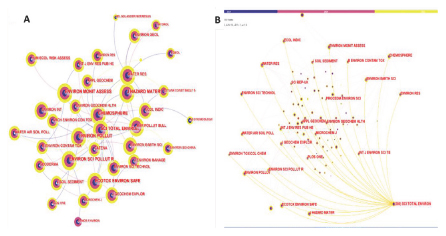
Figure 3:
Top 100 journals in the field of Heavy metals (A) and Ranked 1st in prominent journals (Science of Total Environment) (B)
From the above discussion, it was concluded that due to the increase in industrialization and natural calamities, heavy metal concentrations increase in our environment. It gets accumulated in water as well as soil ecosystem and affects the food web of our ecosystem. To date no such absolute solution is known, still, progress is going on in the field of remediation of Heavy metals. We still do lots of experiments and research which gives reliable results and also apply such policies which help to reduce the use of heavy metal as well helpful to remediate their concentration from the environment at a very effective level.
Prominent Journals
This analysis is employed in this study to examine the structure of subject relationships among journals that publish articles related to heavy metal. It has been considered that co-citation analysis is an efficient method to measure relationships and linkages between journals and to describe mainstream science. In the present study, nearly 500 journals were studied for co-citation analysis, and the top 10 journals are tabulated in Table 3. Out of these, Science of Total Environment ranked first with a co-citation frequency of 380 in terms of the number of articles published in this journal and their citation followed by Chemosphere (343), Environmental Pollution (322), and Environmental Monitoring and Assessment (317). Figure 3(A) presents the co-citation network of the top 100 journals. In this network, journals with high frequency are represented by larger nodes and vice versa. The number of citations represents the influence and importance of that article.[44] However, a few top journals have less frequency but they still published articles on heavy metal with high impact and citations. Figure 3(B) representing the co-citation network of Science of Total Environment concerning other journals shows how much this journal interconnects with other sub-disciplinary journals. Journals with high co-citation frequency may be considered the more visible titles and possibly the more significant.[45]
| Journals (2010-2021) with frequency | Impact Factor | Number of Citations | Degree Centrality | Betweenness Centrality | h-index |
|---|---|---|---|---|---|
| SCI TOTAL ENVIRON (380) | 7.96 | 7570 | 21 | 0.36 | 45 |
| CHEMOSPHERE (343) | 7.08 | 1065 | 15 | 0.15 | 31 |
| ENVIRON POLLUT (322) | 8.07 | 2157 | 9 | 0.06 | 28 |
| ENVIRON MONIT ASSESS (317) | 2.51 | 636 | 19 | 0.17 | 13 |
| ENVIRON SCI POLLUT R (295) | 4.22 | 1368 | 9 | 0.05 | 16 |
| ECOTOX ENVIRON SAFE (269) | 6.68 | 1056 | 12 | 0.11 | 22 |
| J HAZARD MATER (255) | 10.58 | 586 | 8 | 0.03 | 18 |
| MAR POLLUT BULL (228) | 5.55 | 1216 | 11 | 0.08 | 22 |
| WATER RES (221) | 11.24 | 498 | 12 | 0.11 | 17 |
| ENVIRON EARTH SCI (173) | 2.18 | 11 | 11 | 0.08 | 401 |
| Country | Frequency | Degree centrality | BetweennessCentrality |
|---|---|---|---|
| Peoples R China | 206 | 15 | 0.14 |
| India | 31 | 15 | 0.14 |
| Pakistan | 27 | 11 | 0.09 |
| USA | 23 | 19 | 0.19 |
| Bangladesh | 23 | 15 | 0.15 |
| Iran | 20 | 14 | 0.12 |
| Nigeria | 15 | 4 | 0.02 |
| Brazil | 14 | 4 | 0.01 |
| Saudi Arabia | 14 | 14 | 0.12 |
| Malaysia | 13 | 9 | 0.06 |
In Table 3, the Journal of Science of Total Environment shows a higher centrality value, as well as higher occurrence frequency, which signifies that it has greater influence in the field of heavy metal analysis than others. Since this is an international multi-disciplinary natural science journal might be due to this reason it has a higher number of publications as compared to others.
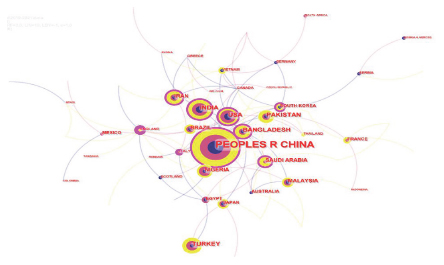
Figure 4:
Countries’ network in the area of heavy metal contamination and remediation
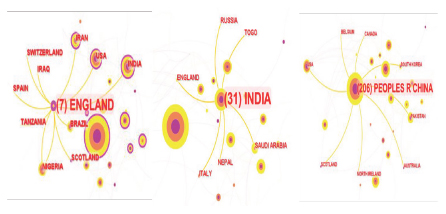
Figure 5:
Linkage network of England, India, and China in the area of heavy metal contamination and remediation
| Institution | Country | Frequency | Degree centrality | Betweenness Centrality |
|---|---|---|---|---|
| Chinese Acad Sci | China | 41 | 13 | 0.17 |
| Univ Chinese Acad Sci | China | 18 | 9 | 0.12 |
| Chinese Res InstEnvironm Sci | China | 12 | 5 | 0.02 |
| Univ Peshawar | Pakistan | 10 | 5 | 0.03 |
| Noakhali Sci andTechnol Univ | Bangladesh | 9 | 5 | 0.03 |
| Nanjing Univ | China | 9 | 7 | 0.05 |
| Beijing Normal Univ | China | 9 | 7 | 0.05 |
| China Univ Geosci | China | 8 | 5 | 0.03 |
| Patuakhali Sci andTechnol Univ | Bangladesh | 7 | 3 | 0.01 |
| Univ Belgrade | Serbia | 6 | 3 | 0.01 |
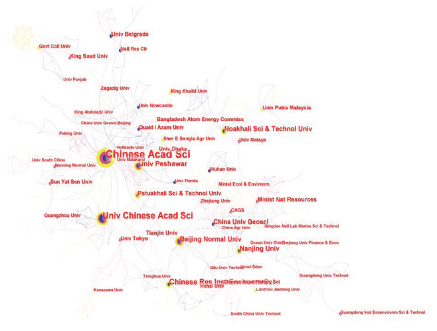
Figure 6:
Institutional networks involved in the heavy metal pollution field
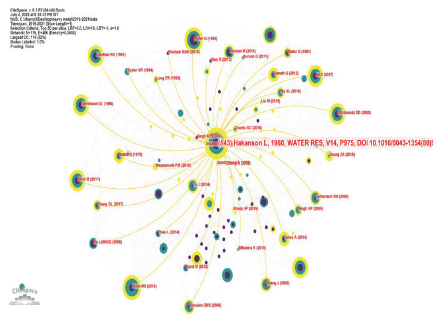
Figure 7:
Network of the key author (Hakanson L)
Countries and Institutions Collaboration in Heavy Metal
Major countries involved in research work on heavy metal contamination and remediation are tabulated in Table 4. The worldwide distribution of publications is not uniform. China is the most active country involved in this area of research followed by India, Pakistan, Turkey, and the USA. A low number of publications from Nigeria, Brazil, Saudi Arabia, and subsequent countries might be due to lacking laboratory infrastructure and required scientific skills. Similarly, in the country cooperation network, China shows the highest node size (Figure 4). Although China and India are the two topmost countries in this field, their cooperation is not close and strengthening shows that the author’s relationship between these two countries is not so good. In the case of the centrality measure among the top 10 countries, England shows the highest result as compared to China and India (Figure 5). This might be because the number of cooperation links in England is higher than in China and India. This cooperation network shows that heavy metal contamination is still a global problem.
| References | Year | Frequency | Degree centrality | Betweenness Centrality |
|---|---|---|---|---|
| Hakanson L, 1980, WATER RES, V14, P975 | 1980 | 143 | 21 | 0.28 |
| Muller G, 1969, J GEOL, V2, P108 | 1969 | 58 | 15 | 0.12 |
| Islam MS, 2015, ECOL INDIC, V48, P282, | 2015 | 54 | 10 | 0.09 |
| Tomlinson DL, 1980, HELGOLANDER MEERESUN, V33, P566, | 1980 | 53 | 18 | 0.15 |
| Macdonald DD, 2000, ARCH ENVIRON CON TOX, V39, P20, | 2000 | 45 | 14 | 0.11 |
| Turekian KK, 1961, GEOL SOC AM BULL, V72, P175, | 1961 | 42 | 14 | 0.11 |
| Varol M, 2011, J HAZARD MATER, V195, P355, | 2011 | 35 | 5 | 0.03 |
| Yi YJ, 2011, ENVIRON POLLUT, V159, P2575, | 2011 | 32 | 18 | 0.14 |
| Ke X, 2017, CHEMOSPHERE, V175, P473, | 2017 | 31 | 7 | 0.05 |
| Tessier A, 1979, ANAL CHEM, V51, P844 | 1979 | 30 | 3 | 0.01 |
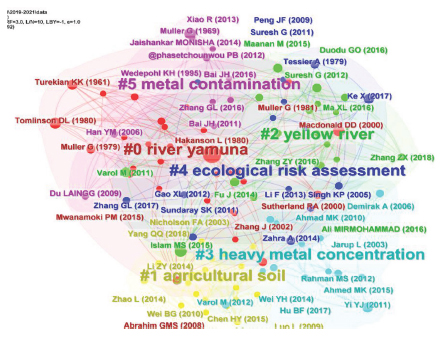
Figure 8:
Key Researchers involved in the heavy metal pollution field
In the case of institutional analysis, again China ranks first in case of occurrence frequency as well as centrality measures (Table 5 and Figure 6). A high degree of centrality indicates that the flow of information is more from Chinese Acad. Sci. This result is also supported by country co-occurrence analysis. This signifies the higher contribution of China in the area of heavy metal contamination and remediation.
Top Researchers in Heavy Metal Pollution
The ten most-cited authors in the specified journals for 2010-2021 are tabulated in Table 6. Authors’ sequence in a publication illustrates their contributions and speciality of research, which offers more information as inputs of author co-citation analysis. Figure 7 depicts the network of Hakanson L with other authors and signifies that he is the most cited author among all. Among the top 10 authors, Hakanson L appears with an occurrence frequency of 143 followed by Muller G and Islam MS with 58 and 54 respectively. The higher value of occurrence frequency signifies that Hakanson L is the most cited author with pioneer work in this area. He discovered the Ecological Risk Index for Aquatic Pollution Control. His focus is not to discover the quality and type of pollution in the aquatic system but he describes how to quantify it. This is the main reason behind his occurrence frequency and large network.
In Figure 8, Scientometrics analysis categorizes the whole data into 6 different groups i.e., Yamuna River, Agricultural soil, yellow river, heavy metal concentration, ecological risk assessment, and metal contamination. Different colours illustrate different authors belonging to that particular area. This analysis signifies that globally, the yellow river from China and the Yamuna River from India are among the most polluted rivers. Numerous research works done on these rivers support this result.[8] Hakanson L at the top position among the top 20 authors belongs to the Yamuna River group while Islam MS is from the Yellow River. This analysis is also supported by country co-occurrence analysis in which China and India are the two top contributing countries in heavy metal pollution research in the river system.
CONCLUSION
Conventional methods in bibliometric analysis, mainly focus on the frequency of keywords, and the number of publication outputs from countries, research institutes, journals, and subject categories. This approach does not completely indicate the development trends within a research field while in recent years, many methods and tools have been used in the bibliometric analysis, such as social network analysis tools and impact factors.[46,47] In this study, we provide a more informed view of the research trends, the most concerned topic, and existing research gaps in the field of heavy metal pollution. Social network analysis has helped to identify the structure and dynamics of the research networks, the key concepts and nodes that play an important role in the network.[48] Bibliometric analysis methods and indicators such as co-authorship network and co-occurrence of author keywords were used to explore the research trend and hot issues of heavy metal pollution. Overall, the Scientometrics analysis outlines the intellectual structure and its evolutionary trajectory in the last 10 years. The emerging trends and patterns identified by Citespace have provided a novel, intriguing and comprehensive view of how the research on the search topic was conducted and what the potential research key areas would be.
The present study reveals how heavy metal pollution becomes a vast problem in a short period. This illustrates that globally the Yellow River and Yamuna River are the two most polluted rivers. From keyword cluster analysis we reveal that Adsorption has been proven to be a useful method for the treatment of heavy metal contaminated water. For effective control, we should determine the source of heavy metal pollution as well as explore the spatial distribution of heavy metal across the river system. We should develop such policies which help to reduce this pollution and focus on developing an efficient and sustainable method that helps to convert the toxic form of metal ions into a non-toxic form. The paper connects to the Sustainable Development Goals (SDGs) 6. It especially addresses the two key targets under this 6.1: Safe and Affordable Drinking Water; 6.2: Improve Water Quality, Wastewater Treatment and Safe Reuse.
Cite this article
Sharma R and Kumari L. Mapping of Heavy Metal Pollution in River System: A Scientometric Approach. J Scientometric Res. 2023;12(2):332-42.
ACKNOWLEDGEMENT
We thank Prof. Sujit Bhattacharya CSIR-NIScPR for his continuous guidance and support and to provide all the necessary research facilities for this research work. The author presented an earlier version of the paper at the National Conference on Information Science and Communication: Opportunities, Expectations and Strategies” 14-15 October 2022, Society for Information Science (SIS) Annual Convention.
We thank Prof. Sujit Bhattacharya CSIR-NIScPR for his continuous guidance and support and to provide all the necessary research facilities for this research work. The author presented an earlier version of the paper at the National Conference on Information Science and Communication: Opportunities, Expectations and Strategies” 14-15 October 2022, Society for Information Science (SIS) Annual Convention.
References
- [Assessed on 25 September 2022];Global Forum for Food and Agriculture. 2017 https://www.gffa-berlin.de/
- World Health Organization. World health statistics 2016:Monitoring health for the SDGs sustainable development goals. World Health Organization. 2016
- Shukla S, Saxena A. Water quality index assessment of groundwater in the central ganga plain with reference to raebareli district, uttar pradesh, india. Current Science. 2020;119(8):1308-15. [Google Scholar]
- Mishra S, Kumar A. Estimation of physicochemical characteristics and associated metal contamination risk in the narmada river, india. Environmental Engineering Research. 2021;26(1) [Google Scholar]
- Setia R, Dhaliwal SS, Kumar V, Singh R, Kukal SS, Pateriya B, et al. Impact assessment of metal contamination in surface water of sutlej river (india) on human health risks. Environmental Pollution. 2020;265:114907 [Google Scholar]
- Kumar V, Parihar RD, Sharma A, Bakshi P, Sidhu GP, Bali AS, et al. Global evaluation of heavy metal content in surface water bodies:a meta-analysis using heavy metal pollution indices and multivariate statistical analyses. Chemosphere. 2019;236:124364 [Google Scholar]
- Yin X, Jiang Y, Tan Y, Meng X, Sun H, Wang N, et al. Co-transport of graphene oxide and heavy metal ions in surface-modified porous media. Chemosphere. 2019;218:1-3. [Google Scholar]
- Sharma R, Singh NS, Singh DK. Impact of heavy metal contamination and seasonal variations on enzyme’s activity of yamuna river soil in delhi and NCR. Applied Water Science. 2020;10:1-8. [Google Scholar]
- Shukla S, Ganguly R, Hussain CM. Hazardous wastes–types and sources. In The Handbook of Environmental Remediation. 2020:24-52. [Google Scholar]
- Tripathi A, Shukla SA. Phytoremediation of lead and copper using and in bareilly, uttar pradesh, india. Pollution Research. 2018;37(4):1109-16. [Google Scholar]
- Armah FA, Quansah R, Luginaah I. A systematic review of heavy metals of anthropogenic origin in environmental media and biota in the context of gold mining in Ghana. International Scholarly Research Notices. 2014:252148-37. [Google Scholar]
- Nordberg GF. Cadmium and health in the 21 century-historical remarks and trends for the future. Biometals. 2004;17(5):485 [Google Scholar]
- Karim MM. Arsenic in groundwater and health problems in bangladesh. Water research. 2000;34(1):304-10. [Google Scholar]
- Koedrith P, Kim H, Weon JI, Seo YR. Toxicogenomic approaches for understanding molecular mechanisms of heavy metal mutagenicity and carcinogenicity. International Journal of Hygiene and Environmental Health. 2013;216(5):587-98. [Google Scholar]
- Niu Y, Jiang X, Wang K, Xia J, Jiao W, Yu H, et al. Meta-analysis of heavy metal pollution and sources in surface sediments of lake taihu, china. Science of the Total Environment. 2020;700:134509 [Google Scholar]
- Hayat MT, Nauman M, Nazir N, Ali S, Bangash N. Environmental hazards of cadmium:past, present, and future. In cadmium toxicity and tolerance in plants. 2019:163-83. [Google Scholar]
- Rahimzadeh MR, Rahimzadeh MR, Kazemi S, Moghadamnia AA. Cadmium toxicity and treatment:An update. Caspian Journal of Internal Medicine. 2017;8(3):135 [Google Scholar]
- Zhang Y, Huo X, Lu X, Zeng Z, Faas MM, Xu X, et al. Exposure to multiple heavy metals is associated with aberrant immune homeostasis and inflammatory activation in preschool children. Chemosphere. 2020;257:127257 [Google Scholar]
- Cai C, Zhao M, Yu Z, Rong H, Zhang C. Utilization of nanomaterials for remediation of heavy metal (loid) contaminated sediments:A review. Science of the Total Environment. 2019;662:205-17. [Google Scholar]
- Ouyang W, Wang Y, Lin C, He M, Hao F, Liu H, et al. Heavy metal loss from agricultural watershed to aquatic system:A scientometrics review. Science of the total environment. 2018;637:208-20. [Google Scholar]
- Maurya PK, Malik DS, Yadav KK, Kumar A, Kumar S, Kamyab H, et al. Bioaccumulation and potential sources of heavy metal contamination in fish species in river ganga basin:possible human health risks evaluation. Toxicology Reports. 2019;6:472-81. [Google Scholar]
- Rajeshkumar S, Li X. Bioaccumulation of heavy metals in fish species from the Meiliang Bay, Taihu Lake, China. Toxicology Reports. 2018;5:288-95. [Google Scholar]
- Lin T, Nan X. A scoping review of emerging COVID-19 health communication research in communication and media journals. Health Communication. 2022:1-2. [Google Scholar]
- Irfan M, Liu X, Hussain K, Mushtaq S, Cabrera J, Zhang P, et al. The global research trend on cadmium in freshwater:a bibliometric review. Environmental Science and Pollution Research. 2021:1-4. [Google Scholar]
- Li C, Zhou K, Qin W, Tian C, Qi M, Yan X, et al. A review on heavy metals contamination in soil:effects, sources, and remediation techniques. Soil and Sediment Contamination:An International Journal. 2019;28(4):380-94. [Google Scholar]
- Wang J, Cai Y, Yang J, Zhao X. Research trends and frontiers on source appointment of soil heavy metal:a scientometric review (2000-2020). Environmental Science and Pollution Research. 2021;28(38):52764-79. [Google Scholar]
- Chen H, Teng Y, Lu S, Wang Y, Wang J. Contamination features and health risk of soil heavy metals in china. Science of the Total Environment. 2015;512:143-53. [Google Scholar]
- Wang Z, Zhao Y, Wang B. A bibliometric analysis of climate change adaptation based on massive research literature data. Journal of Cleaner Production. 2018;199:1072-82. [Google Scholar]
- Tian X, Geng Y, Sarkis J, Zhong S. Trends and features of embodied flows associated with international trade based on bibliometric analysis. Resources, Conservation and Recycling. 2018;131:148-57. [Google Scholar]
- Tchounwou PB, Yedjou CG, Patlolla AK, Sutton DJ. Heavy metal toxicity and the environment. Molecular, Clinical and Environmental Toxicology:Environmental Toxicology. 2012;3:133-64. [Google Scholar]
- Rodgers KJ, Hursthouse A, Cuthbert S. The potential of sequential extraction in the characterisation and management of wastes from steel processing:a prospective review. International Journal of Environmental Research and Public Health. 2015;12(9):11724-55. [Google Scholar]
- Aronsson P, Perttu K. Willow vegetation filters for wastewater treatment and soil remediation combined with biomass production. The Forestry Chronicle. 2001;77(2):293-9. [Google Scholar]
- Jackson AP, Alloway BJ. The transfer of cadmium from sewage-sludge-amended soils into the edible components of food crops. Water, Air, and Soil Pollution. 1991;57:873-81. [Google Scholar]
- Muchuweti M, Birkett JW, Chinyanga E, Zvauya R, Scrimshaw MD, Lester JN, et al. Heavy metal content of vegetables irrigated with mixtures of wastewater and sewage sludge in zimbabwe:implications for human health. Agriculture, Ecosystems and Environment. 2006;112(1):41-8. [Google Scholar]
- Briffa J, Sinagra E, Blundell R. Heavy metal pollution in the environment and their toxicological effects on humans. Heliyon. 2020;6(9) [Google Scholar]
- Tack FM, Verloo MG. Leaching behaviour and solid phase fractionation of selected metals as affected by thermal treatment of polluted sediment. International Journal of Environmental Analytical Chemistry. 1993;51(1-4):167-75. [Google Scholar]
- Sun Y, Wu S, Gong G. Trends of research on polycyclic aromatic hydrocarbons in food:a 20-year perspective from 1997 to 2017. Trends in Food Science and Technology. 2019;83:86-98. [Google Scholar]
- Bradl H. Heavy metals in the environment:origin, interaction and remediation. Elsevier. 2005 [Google Scholar]
- Yalcin MG, Coskun B, Nyamsari DG, Yalcin F. Geomedical, ecological risk, and statistical assessment of hazardous elements inshore sediments of the iskenderun gulf, eastern mediterranean, turkey. Environmental Earth Sciences. 2019;78:1-28. [Google Scholar]
- Leventeli Y, Yalcin F. Data analysis of heavy metal content in river water:multivariate statistical analysis and inequality expressions. Journal of Inequalities and Applications. 2021;2021:1-22. [Google Scholar]
- Alnashiri HM. A brief review on heavy metal bioaccumulation studies from red sea. Adsorption Science and Technology. 2022 [Google Scholar]
- Pan L, Wang Y, Ma J, Hu Y, Su B, Fang G, et al. A review of heavy metal pollution levels and health risk assessment of urban soils in chinese cities. Environmental Science and Pollution Research. 2018;25:1055-69. [Google Scholar]
- Bassyouni D, Mohamed M, El-Ashtoukhy ES, Abd El-Latif M, Zaatout A, Hamad H, et al. Fabrication and characterization of electrospun Fe3O4/o-MWCNTs/polyamide 6 hybrid nanofibrous membrane composite as an efficient and recoverable adsorbent for removal of Pb (II). Microchemical Journal. 2019;149:103998 [Google Scholar]
- Huang L, Zhou M, Lv J, Chen K. Trends in global research in forest carbon sequestration:a bibliometric analysis. Journal of Cleaner Production. 2020;252:119908 [Google Scholar]
- Tsay MY, Xu H, Wu CW. Journal co-citation analysis of semiconductor literature. Scientometrics. 2003;57(1):7-25. [Google Scholar]
- Li B, Hu K, Lysenko V, Khan KY, Wang Y, Jiang Y, et al. A scientometric analysis of agricultural pollution by using bibliometric software VoSViewer and Histcite™. Environmental Science and Pollution Research. 2022;29(25):37882-93. [Google Scholar]
- Zhang Y, Li C, Ji X, Yun C, Wang M, Luo X, et al. The knowledge domain and emerging trends in phytoremediation:a scientometric analysis with CiteSpace. Environmental Science and Pollution Research. 2020;27:15515-36. [Google Scholar]
- Bhattacharya S. Some salient aspects of machine learning research:a bibliometric analysis. Journal of Scientometric Research. 2019;8(2s) [Google Scholar]

